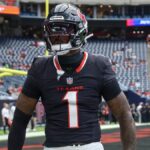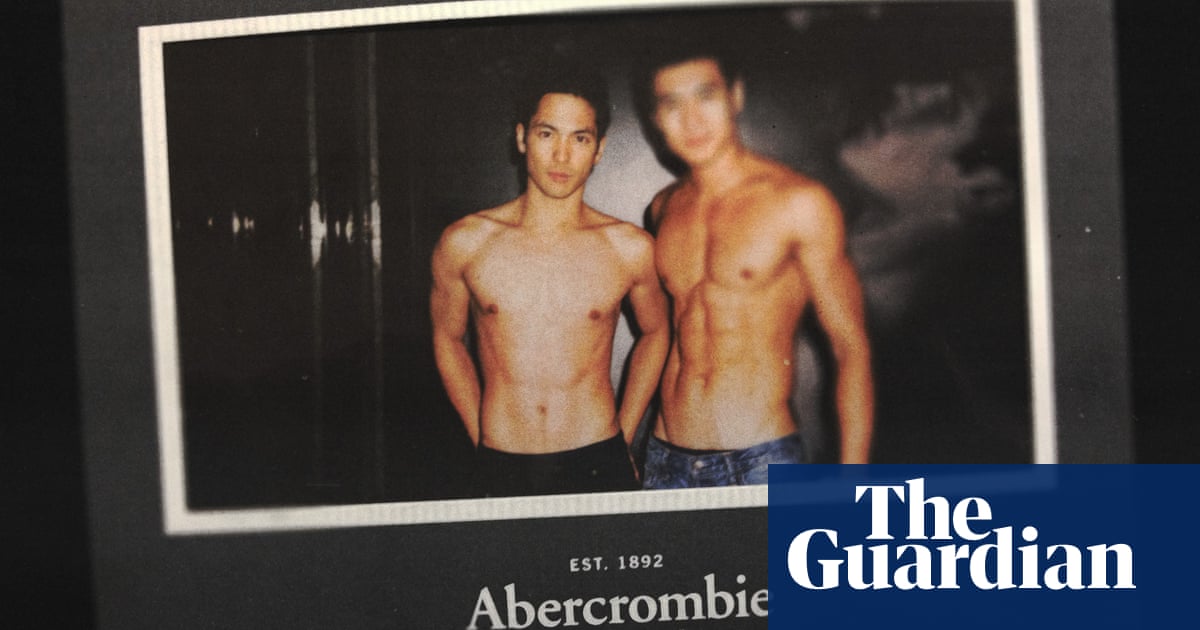Something felt off about Kai Braden’s first day working retail at an Abercrombie & Fitch store in 2006. His bosses sat him down to watch an onboarding video, but instead of learning how to properly fold shirts or work the register, Braden watched a corporate-produced montage of young men romping through fields in various stages of undress.
“[It was] stock footage of shirtless guys with their jeans falling down so you could see a little bit of their butt,” Braden remembered. He struggled to understand how this would relate to his job. “I was like, ‘What does this have to do with anything?’”
Quite a lot, in fact: Braden’s responsibilities, along with greeting customers and ringing up purchases, included standing outside Abercrombie, beckoning shoppers inside with his washboard abs and megawatt smile.
Most millennials remember mid-aughts Abercrombie for one thing: the young men, usually no older than 21, who posed for Polaroids with teenage girls in suburban malls across the US. Shirtless greeters were key to Abercrombie’s marketing plan, and Braden joined their ranks at a store in downtown New York City. (He also went on to work at the Fifth Avenue location.) Nearly two decades later, he looks back at his time at Abercrombie as representative of fashion’s dark side: exploitative, exclusionary and often lacking safeguards for young, vulnerable workers. His advocacy around these issues has helped secure important protections for models in New York starting in 2025.
Abercrombie in the mid-aughts was a hypersexualized environment. Teenagers in search of bootcut jeans or polo shirts were greeted by an all-out assault on the senses: thumping club music, moody lighting and sickeningly sweet perfume. Even Braden’s job title – “model”, which is what Abercrombie called its salespeople – projected a certain status.
“Abercrombie was an intimidating place to walk into,” said Tyler McCall, a writer and former editor-in-chief of the trade website Fashionista. “I remember being 16 and seeing the shirtless guys and thinking they were hot. But it was also like, what am I supposed to do with this? It felt like visiting Santa and sitting on his lap.”
Braden took the job at age 18, after he graduated high school, moved to New York and signed as a model with the Wilhelmina agency. His agent told him that working at Abercrombie was a good way to make money in between bookings – a nice alternative to traditional survival jobs like waiting tables.
As a mixed-race model who is half-white and half-Asian, Braden “felt like the token Asian”. Most of the greeters were white, and Black and Latino workers were “definitely” put in the back room, folding shirts rather than interacting with customers or posing for shirtless pictures, he said. While this treatment made store employees uncomfortable, many did not speak out for fear of retaliation, and because lack of diversity was ingrained in Abercrombie’s DNA.
“I hit the ethnic checkbox they needed for corporate,” Braden said. “I was thankful to be there, but I also noticed there weren’t a lot of [people like] me. There could only be so many of us. It wasn’t a hidden thing: everyone could see that all the ethnic people were put in the back.”
The store’s discriminatory hiring practices in the mid-aughts were well-documented, and have been the subject of lawsuits and a 2022 Netflix documentary. One 2003 class-action suit in California alleged that Abercrombie discriminated against minorities and women in its hiring and marketing practices. The brand settled for $40m and did not admit wrongdoing, though it was required to hire a diversity officer.
Braden was paid $100 to stand outside the store during his four-hour shift, which felt like a lot of money at the time. “A lot of teen girls would get excited, and it felt like a celebration of the brand,” he said. Sometimes, customers crossed a line.
“Etiquette just goes out the window, especially in a high traffic store,” Braden said. “Because we were models, people think we’re cool if we’re touched and grabbed. People would grab me by the waist and pull me in, which felt weird.”
At the time, Braden said Abercrombie did not provide training on how to handle non-consensual touching. “We were put in a vulnerable situation from the get-go, and all they told us was to grab a manager if something seriously wrong went down.”
Braden says he understood the way models were treated at Abercrombie was wrong, but he was young and new to the industry. “When you’re 18, you say yes to every opportunity,” he said. “I was wide-eyed and didn’t want to be the problem.”
The Abercrombie gig took Braden from New York to working at stores in London and Los Angeles. Eventually he moved on to acting, appearing on Magnum PI and Orange Is the New Black, and in commercials and music videos. Abercrombie moved on, too. In 2015, after years of slumping sales, the company banned “sexualized marketing” in its stores, nixing the need for shirtless greeters. In 2017, the brand tapped a new CEO, Fran Horowitz, and under her leadership ditched its preppy aesthetic for more classic, tailored basics. The rebrand paid off: according to Fast Company, Abercrombie generated more than $4.03bn in 2023, going “from America’s most hated retailer to a gen Z favorite”.
Still, the ghosts of Abercrombie past continue to haunt the company. In 2018, in the wake of the #MeToo movement, multiple men came forward alleging sexual harassment during Abercrombie photoshoots by one of the brand’s favorite photographers, Bruce Weber. (Weber denied the allegations at the time.) This past October, the former CEO Mike Jeffries pleaded not guilty to 16 criminal charges after a federal indictment alleged that Jeffries, his partner Matthew Smith, and James Jacobson, an employee of Jeffries, operated an international sex-trafficking and prostitution business made up of more than a dozen aspiring Abercrombie models from 2008 to 2015. (Jeffries’s lawyers say he has dementia; a competency hearing is scheduled for June. Representatives for Abercrombie did not respond to a request for comment.)
Braden said he was surprised “it took this long” for Jeffries to face charges. “This happened 15 years ago, and #MeToo happened in 2017. Why is this just now becoming a thing?” Braden said. “I wonder if it has anything to do with the stigma around men and assault.”
Even as the type of Y2K fashion that Abercrombie was famous for comes back into style – low-rise jeans, baby tees – the company has shied away from reviving old looks. “I’m surprised they don’t capitalize on that era that’s having such a moment,” McCall, the fashion writer, said. “But they can’t do that, because it’s all connected to these toxic memories of what the brand used to be.”
In 2018, Braden came forward to share a story on social media of sexual assault he experienced during a photo shoot – one unrelated to Abercrombie. Soon after, he connected with the Model Alliance, a non-profit that advocates for fashion workers’ rights. With the Model Alliance, Braden worked on New York’s Adult Survivors Act, which temporarily lifted the statute of limitations for victims of sexual offenses to sue their abusers. (Donald Trump was found liable for sexually abusing the writer E Jean Carroll after she sued him under the law in 2022.)
Braden also campaigned for the Fashion Workers Act, a New York law that establishes health and safety protections for models on set, creates a safe channel to file complaints, and protects models against retaliation from employers. “These are basic labor protections that are long overdue,” he said. In December, more than 200 models including Christy Turlington, Helena Christensen and Beverly Johnson signed an open letter urging the New York governor, Kathy Hochul, to sign the bill into law.
Sara Ziff, a former model and founder of the Model Alliance, said that the law was “a major victory” for models, many of whom are very young. “Since its inception, the fashion industry has been a backwater for workers’ rights, camouflaged by glamour and rife with a range of abuses, including financial and sexual exploitation. The Fashion Workers Act will regulate predatory model management companies and extend labor protections to working and aspiring models in New York – one of the fashion capitals of the world.”
The law, which goes into effect in June 2025, is the first of its kind, but Ziff said the Model Alliance planned to build on the progress to “set an example for other fashion capitals around the world”.
Braden doesn’t regret his time working at Abercrombie – it gave him a steady income and allowed him to live in three exciting cities – but he believes it’s important to speak about the mistreatment of models, and how companies like Abercrombie made money off their labor. “I always like to think there’s a silver lining to everything,” he said. “If people can see what happened, then we can grow as a culture and community.”









